In a competitive and saturated digital landscape, winning customers’ attention has never been more challenging. According to a Statista report, over 6 million people globally shop online each minute.
But thanks to visual marketing, brands can captivate audiences and capture their attention more than traditional marketing tactics, making visual marketing the standard among digital marketers. And a major component to successfully win over audiences is UGC.
According to an IAB report, user generated content (UGC) is 50% more trusted than any other media, making customer reviews, star ratings, and social proof essential for eCommerce marketers.
A derivative of UGC is visual user generated content (VUGC). Visual content generated by shoppers — like photo reviews, unboxing videos, and social media product tags — builds brand trust, increases discovery, and most importantly, empowers shoppers throughout the entire customer journey. While displaying VUGC is quite intuitive, the challenges behind collecting it and harnessing its potential still remain.
To understand how eCommerce brands can unlock the potential of visual marketing, let’s explore the ins and outs of VUGC and UGC.
What is VUGC?
Visual user generated content (VUGC) includes any photos, videos, or other forms of online multi-media-driven content generated by end-users of a product or service. Today, VUGC exists as image-based digital content created by consumers.
The difference between UGC and VUGC
User-generated content is an umbrella term that refers to any and all content created by consumers. Some common examples of UGC content types include:
-
Star ratings
-
Product reviews
-
Site reviews
-
Testimonials
-
Photo & video reviews
-
Q&A forums
While UGC and VUGC are quite similar, the distinction is made to differentiate their varying benefits as well as their usability. For instance, let’s say you are shopping for a new pair of shoes. UGC, such as star ratings that populate under products on Google’s search page, can give you a quick snapshot of highly rated products and trusted brands. This helps you more quickly narrow down your search to help you find the perfect pair.
On the other hand, VUGC, in the form of a video review from a happy customer, wouldn’t be as helpful on Google Shopping’s results page but would shine on a product page, helping reinforce buyer confidence in the decision-making phase.
However, that same video review would do wonders on a product page, helping shoppers decide on the right size or maybe even inspire them to try a new color. Plus, that video review will give you the extra boost — that we sometimes need when shopping online. This helps customers feel confident at checkout and can help lower the chance of returns.
The benefits and importance of VUGC
While the benefits between UGC and VUGC are quite similar, here are some areas where VUGC stands out.
Expedites the path to purchase
VUGC expedites shoppers’ decision-making process. For example, photo reviews on a product page give shoppers confidence that they are making the right decision, whether it be in helping customers find the correct style, sizing, etc.
One brand giving their shoppers confidence at every stage is Girlfriend Collective. The brand, an inclusive and sustainable activewear brand, is committed to promoting size-inclusivity. To support their brand mission, Girlfriend Collective includes VUGC throughout their site, so customers get a genuine understanding of how their clothes fit on real bodies in real life.
Reinforces brand recognition and messaging
With VUGC, marketers can create a curated visual feed (themed gallery of VUGC) that can enhance branding and contribute to the overall sentiment of a product or brand. A customized branded gallery works with customer reviews by taking VUGC and sorting it according to color, product, and type. This helps brands curate a vibe that elevates photo and video reviews, leaving a lasting impression, one that can’t always shine through via text.
Meets customers where they are — on mobile
With more and more shoppers on their mobile devices, either to shop, go on social, or simply text, brands must create alternative shopping experiences that cater to mobile shopping as opposed to online desktop shopping. To stay competitive in a saturated mobile commerce market, brands are turning to SMS marketing to push marketing campaigns, so they can always stay top of mind. Namely, brands can send photo and video reviews of their most popular products via SMS abandoned cart flows.
Not only does SMS provide convenience for your customers, but by meeting them where they spend their time, SMS can enhance your reviews strategy with curated SMS flows. These automated messages that are triggered by customer actions can help brands boost review collection by up to 66% and reduce cart abandonment with SMS messaging highlighting UGC and star ratings.
Helps collect customer sentiment and product insights
Understanding customer sentiment is key in creating products that resonate with customers. By tracking UGC like written reviews, photo and video reviews, and star ratings, brands can understand what customers actually love. Brands can then improve any on-site messaging and product descriptions and can even adjust products that customers aren’t positively responding to. Additionally, UGC also helps improve a brand’s first impression and boost brand sentiment. Star ratings populate as Google Seller Ratings and can appear on Google Ad campaigns.

Yotpo VUGC Dashboard
How eCommerce brands are using visual marketing
1. Brand discovery with micro-influencers
With over 200 million active businesses on Instagram, Facebook, and more, staying competitive on social media is crucial for a successful visual marketing strategy.
Brands that are leveraging UGC through micro-influencers are strengthening their brand awareness and building community with their customers. Influencer marketing, the sharing of personal photos and video content about brands or products by social media influencers, helps create an emotional connection with followers and shoppers.
An even more compelling reason to leverage UGC and influencers is that 61% of social media users are more likely to trust a brand recommended by a friend or influencer on social, compared to only 38% from ads generated by the brands themselves, according to a Business Wire report.
2. Creating captivating, on-site visual experiences
As mentioned earlier, VUGC expedites the decision-making process along the path to purchase by empowering customers to feel confident throughout their shopping experience. And one area of focus to help win over your customers is through on-site experiences.
One example of a brand successfully leveraging on-site VUGC is the skincare brand Barefaced. Barefaced is cutting through the noise by taking a UGC campaign to another level with a Before and After photo review campaign. Ultimately, Barefaced leveraged Before and After photo submissions from actual customers, showing what shopper’s skin looked like before using the product and after using them. These photos cultivated trust in a captivating and unique way.

Barefaced Before & After Campaign
Barefaced’s ability to cultivate trust and create an online community helps them stay competitive in an industry that must cater to the varying and unique needs of every shopper. As a result, Barefaced is seeing a 3X click-through rate (CTR) from their on-site VUGC Gallery.
3. Reaching shoppers on social
Because 70% of shopping enthusiasts turn to Instagram for product discovery, social proof is key in creating a competitive visual marketing approach. Meaning cultivating a culture of user generated content such as social reviews, on-site Instagram Galleries, and overall engagement on social media is necessary for brands.
One quick way brands can do this is by syncing your UGC, specifically ratings, reviews, and published Q&A with review syndication to Shops on Facebook and Instagram. Syndicating your ratings, photo reviews, and video reviews to Facebook and Instagram builds social proof, strengthening trust between eCommerce brands and shoppers on social media.
Likewise, as eCommerce and social commerce coalesce, VUGC is necessary for generating social proof for product discovery, brand trust, and conversion, making shoppable social media standard practice for many brands. Shoppable Instagram puts brands with audiences regularly interacting on social networks, boosting their social commerce strategy.
Creating curated visual shopping experiences with VUGC
Ultimately, both VUGC and UGC play an important role in helping brands stand above the competition. Similarly, as social commerce and mobile commerce continue to climb in popularity, brands will need to think outside the box in their content marketing strategy. With VUGC built into your visual marketing strategy, you can give your customers what they want — a captivating and curated visual shopping experience.



